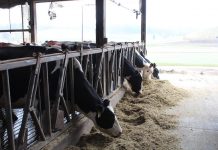Who wants to be a millionaire? If we are talking about owning dollars, lots of people would volunteer. If we are talking about milk sold per worker, we would usually say yes, at least a million pounds per worker.
But a funny thing happened this year, or rather last year according to the recently released 2012 Northeast Dairy Farm Business Summary — only one of the five categories of “Winning Management Styles of the Top 25%” turned out to be “millionaires” — when it came to milk sold per worker.
Summary
A total of 504 herds participated in their 2012 summary, and looking at averages, those 504 herds were millionaires, averaging 1.1 million pounds of milk sold per worker. As a whole group, the top 25 percent of the herds were also millionaires, and averaged 1.2 million pounds of milk per worker. But that was because one of the 5 groups that made up the top 25 percent, the 44 “Labor Efficient” herds sold more than 1.4 million pounds of milk per worker.
Every other group including the “Great with Cows” (25 farms) at 966,666 pounds, the “Better Milk Price” (17 farms) at 845,311 pounds, the “Tight with a Buck” (26 farms) at 901,305 pounds, and the “Balanced” (14 farms) at 793,749 pounds of milk sold per worker were below that million pound mark.
One of the first rules of benchmarking is never look at just one number and then make conclusions or decisions. In the net earnings per cow category, the 504 herds averaged $415 in 2012, while the top 25 percent averaged $939 per cow.
Interestingly, the “Labor Efficients” that sold the most milk per worker in the top 25 percent at more than 1.4 million pounds per worker, had the lowest net earnings per cow of $820 of the top 25 percent herds in 2012 (let’s be fair here, that is still really good!).
“Great with Cows” averaged $913, the “Better Milk Price” averaged $864, the “Tight with a Buck” $1,276, and the “Balanced” $829.
All of these being much, much better than the average performance.
These herd’s managers optimized income for their sets of resources. 2012 feed supplies, prices and milk prices did not support pushing high-priced feed to cows to produce milk that was not worth the additional cost.
Even with moderating feed prices, managers who want to break into that top 25 percent or stay in it, should continue to diligently ask and answer those questions such as: will it pay me to push for that additional “x” pounds of milk at “y” cost?
Changing. This year’s report illustrates both what I love and what is frustrating about our dairy industry. There are many ways to be successful in the dairy business, but the industry is constantly changing.
Maybe bending is a better word sometimes, as there is a certain ebb and flow. We have some fundamental rules and benchmarks, but we have to evaluate them regularly in the context of what is happening in the industry today. You might not always want to be a millionaire — in pounds of milk sold per worker, that is.
STAY INFORMED. SIGN UP!
Up-to-date agriculture news in your inbox!












